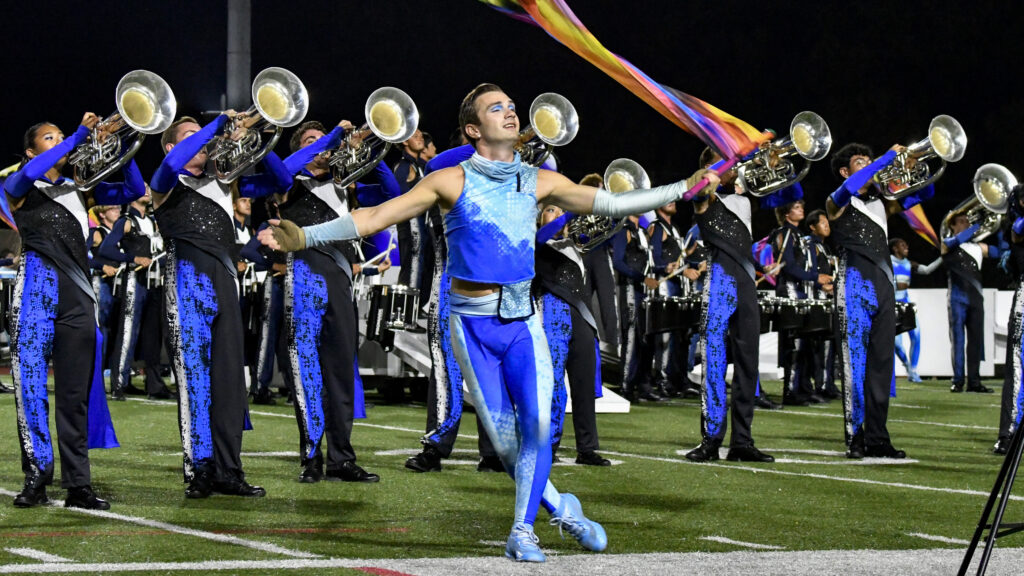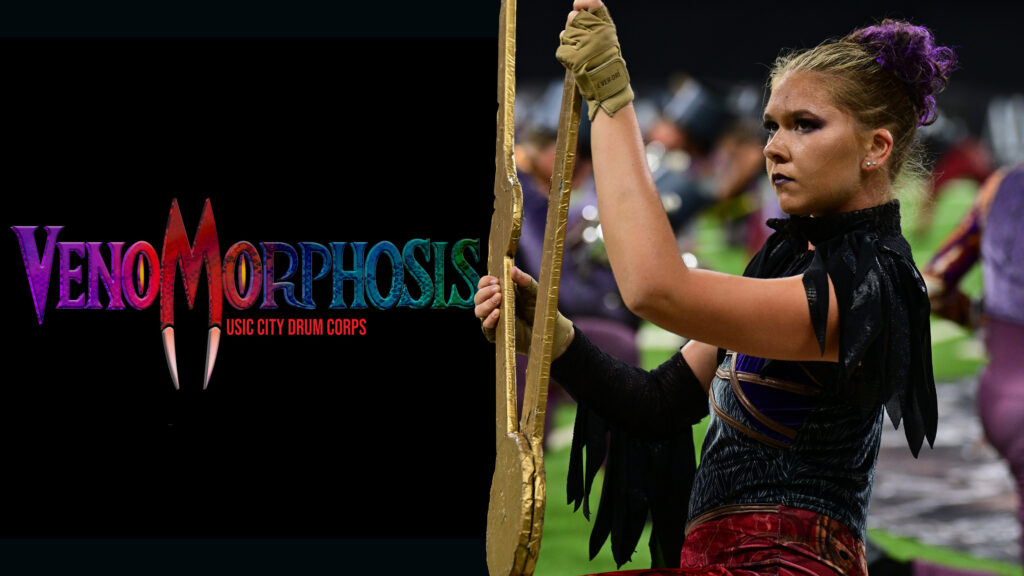Just south of Boston, Marciano Stadium in Brockton, Massachusetts served as the site of the 2005 Drum Corps International World Championships for DCI’s Division II and III corps.
After Prelims and Finals competitions, fans packed the stadium for the Grand Finals to see the top-12 highest scoring corps from the Division II & III Finals, regardless of class. The heat of the late morning and early afternoon was extremely oppressive for fans and marchers alike, and it was a credit to those on the field that the members were not content to rest on the laurels of what they accomplished in the division Finals two nights before.
Spartans had earlier won their fourth Drum Corps International Division II Championship by sixth tenths of a point over East Coast Jazz. But in the Grand Finals, the Massachusetts-based Jazz came out on top by just over three tenths of a point to top the Spartans.

The East Coast Jazz program titled “Stolen Moments: A Time & Place in Jazz” went on a nationwide journey to some of the greatest and most significant club venues in American jazz history. The show chronicled the evolution of America’s indigenous music from vaudeville and the early big band years through the growth of contemporary jazz.
The show opened with a segment titled, “Storyville: 1917,” which included a short rendition of “Amazing Grace,” then proceeded to “That’s A-Plenty.”
Storyville was known as New Orleans’ red light district between 1897 and 1917, established by municipal ordinance to direct all the city’s less desirable elements into one easily controlled neighborhood. The presence of a nearby train station made it possible for visitors to attend the jazz clubs that proliferated the community. There, they were introduced to New Orleans jazz before the idiom was discovered by the rest of the country.
“Amazing Grace” didn’t originate in New Orleans, but became a popular and powerful spiritual in the Deep South despite the fact that the tune was written by a former captain of an English slave ship who eventually became a leading abolitionist. The show started with a brief quote of the tune played by a few horns, accompanied by a heartbeat-like drumbeat.
The other segment of “Storyville: 1917” featured “That’s A-Plenty,” an upbeat 1914 ragtime piano work written by Lew Pollack and first recorded in 1917. Though originally a rag, the tune is now a standard of the Dixieland jazz repertoire and was often utilized in Jackie Gleason’s 1950s and 1960s television shows. The corps’ treatment of the piece was whimsical, accenting the player piano nature of it. The work culminated with the corps blasting the “Amazing Grace” theme.

The second segment of the show was “The Cotton Club: 1927,” named after the famed New York City nightclub originally located in Harlem from 1923-1935 before moving to midtown Manhattan. Originally a club for whites only, the establishment ironically introduced its patrons to many of the most popular black entertainers and big bands of the day, including acts such as Duke Ellington, Count Basie, Louis Armstrong, Billie Holiday and Lena Horne.
Featured in this section was Duke Ellington’s “Mood Indigo,” a piece composed for a radio broadcast in 1930 originally titled “Dreamy Blues.” An instant hit, it promted jazz promoter Irving Mills to write lyrics and rename the piece, “Mood Indigo.”
East Coast Jazz opened the work with a trumpeter utilizing a plunger mute for a “wah-wah” effect, accompanied by a baritone player. This was followed by a drum feature that recreated a club drumset solo.

That percussion feature led into “Carvavan,” often attributed to Duke Ellington but written by Juan Tizol, trombonist for Ellington’s band. It was originally recorded in 1936 by members of the Ellington band, with Ellington playing piano. However, instead of being identified as the Ellington band, the group was named Barney Bigard and His Jazzopators. Ellington, a consummate businessman, recognized that he could sell more records if his name wasn’t on all the recordings. Jazz fans bought the recording by the Jazzopators and several other recordings of the same tune by other ensembles, unaware that members of the Ellington band recorded each of the versions.
The third segment of the show was titled “Roseland Ballroom: 1932,” set in New York’s theater district during the Great Depression. All the famous big bands played the venue, and hundreds of radio broadcasts from Roseland still survive. Johnny Green’s “Body and Soul” was first performed in London in 1930 and soon made its way back to New York, where it was written. First heard in the USA in the Broadway musical revue, “Three’s a Crowd,” it was quickly recorded by multitudes of jazz performers, including Louis Armstrong and Paul Whiteman.
The front ensemble percussion section played a piano-like accompaniment here to back up the opening trumpet solo, much like a club pianist would accompany a featured soloist.

The final segment of the show was “Berklee College of Music: 1972,” celebrating the famed Boston music school that lies just eight miles from the corps’ hometown. Berklee is the largest independent college focused on contemporary music in the world and is especially known for the study of jazz and modern American music.
This closing section featured Chick Corea’s “La Fiesta” from his “Return to Forever” album of 1975. Jazz pianist Corea wasn’t a student at Berklee, but grew up across the river from Boston. The song, combining jazz/rock fusion with Latin styles, is a celebration of flamenco, the folk music of southern Spain’s Andalusia region.
Flamenco dancer skirts inspired the colorful diagonally striped flags that helped the East Coast Jazz show reach the temperature of the surrounding environment.

Michael Boo was a member of the Cavaliers from 1975-1977. He wrote about the drum corps activity for more than 35 years while serving as a staff writer for various Drum Corps International projects. During his lifetime Boo wrote for numerous other publications including an honors-winning book on the history of figure skating. He also was an accomplished composer. Boo passed away in 2020 and was inducted into the DCI Hall of Fame posthumously in 2021.





